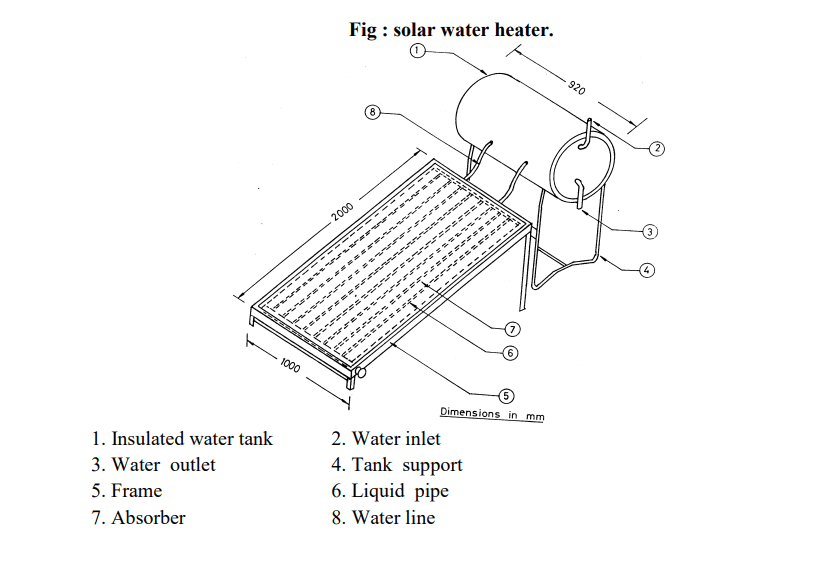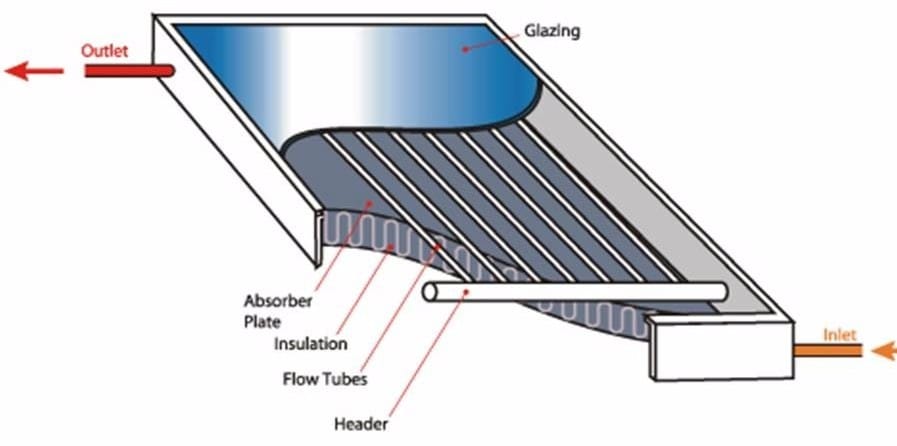Solar Water Heaters – Principle and Applications
Introduction; Solar water heaters (SWHs) are devices that harness solar energy to heat water. These systems are environment-friendly, renewable, and offer a sustainable alternative to conventional water heating methods, which often rely on fossil fuels.
Advantages of Solar Energy:
- Inexhaustible and renewable
- Pollution-free
- No production of greenhouse gases or toxic by-products
- Reduces dependency on non-renewable energy sources
- Available in abundance in a country like India
Solar Energy Potential in India
- Total land area: 3.28 × 10¹¹ m²
- Average sunshine days/year: ~300 days
- Average solar insolation: 500 W/m²
- Sunshine hours/day: 5 hours
Calculated Potential:
- Total energy/day: 3.28 × 10¹¹ × 500 × 5 × 3600 = 2.952 × 10¹µ J = 2.952 × 10⁹ MJ/day
- Annual energy: 2.952 × 10⁹ MJ/day × 300 = 8.856 × 10¹¹ MJ/year
- If 1% land is used with 10% efficiency: 8.856 × 10¹¹ × 0.01 × 0.1 = 8.856 × 10⁸ MJ/year usable energy
Principle of Solar Water Heater
“Solar radiation is absorbed by a black surface and transferred to water, raising its temperature.”
- Works on the Thermosyphon principle (natural circulation due to density difference in hot and cold water)
- Water circulates without any mechanical pump
Heat Transfer:
- Radiation: Solar rays absorbed by black surface
- Conduction: Heat transferred to water through metal
- Convection: Heated water rises, cool water sinks

Main Components
- Solar Collector: Absorbs solar radiation and transfers heat
- Storage Tank: Insulated container to store hot water
- Piping System: Connects collector to tank and usage points
- Mounting Stand: Keeps collector at optimal angle (usually 11° facing south)
Types of Solar Collectors
a) Based on Collecting Characteristics:
- Flat-Plate Collectors (FPC): Flat absorbing surface without focusing
- Concentrating Collectors: Use reflectors/lenses to focus sunlight
b) Based on Mounting:
- Fixed Tilt: Angle adjusted seasonally
- Tracking: Moves with sun (expensive)
c) Based on Fluid:
- Liquid-based: Water, glycol solution
- Air-based: Air as heat transfer medium
Construction of Flat-Plate Collector
- Absorber Plate: Corrugated GI sheet, painted black
- Tubes: 12 mm GI or copper in serpentine form
- Insulation: Wooden box with thermal insulation (glass wool/mineral wool)
- Cover: Glass/plastic sheet (transparent)
- Storage Drum: Insulated tank above the collector
- Stand: Angle iron frame for tilting at 11°

Specifications:
- Absorber plate thickness: 1–2 mm
- Tube diameter: 1–1.5 cm
- Glass cover thickness: 4 mm (tempered)
System Working
- Cold water from overhead tank enters collector
- Absorber plate heats up under sun
- Water in tubes heats and rises to storage tank
- Natural circulation continues as long as sunlight is available
- Hot water available at 55–63°C
- Overnight heat loss: 4–8°C
Capacity and Installation
- Basic unit: 100 litres/day
- Area required: 25 sq. ft for collector + 10 sq. ft for accessories
- Usage: Suitable for 4–6 family members
- Lifespan: 15+ years
Applications
- Domestic: Bathing. Kitchen washing
- Commercial: Hotels. Hospitals. Hostels
- Industrial: Boiler feed water. Food processing (e.g., dairy, jaggery units)
- Agricultural: Cleaning equipment. Pre-heating in solar dryers
Advantages
|
Feature |
Advantage |
|
Eco-friendly |
No emissions |
|
Cost-saving |
Reduces electricity bills |
|
Renewable |
Solar energy is free and abundant |
|
Low maintenance |
Long life with minimal upkeep |
|
Energy independence |
Reduces dependency on grid/fossil fuels |
Limitations
|
Limitation |
Explanation |
|
Weather-dependent |
Inefficient on cloudy days |
|
Space requirement |
Needs rooftop area |
|
Initial cost |
High upfront investment |
|
Low water pressure |
May not suit multi-storey buildings without pump |

